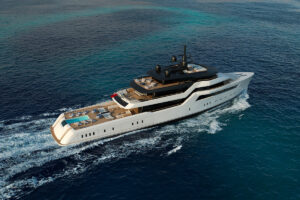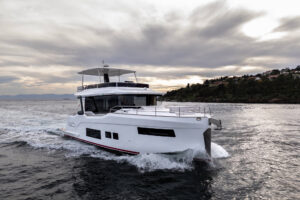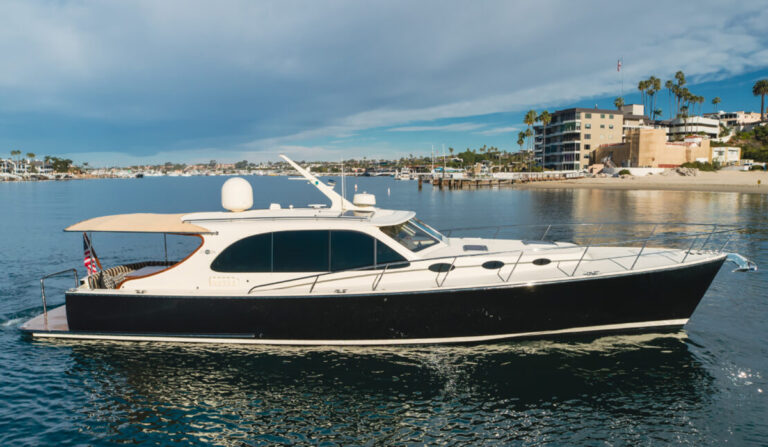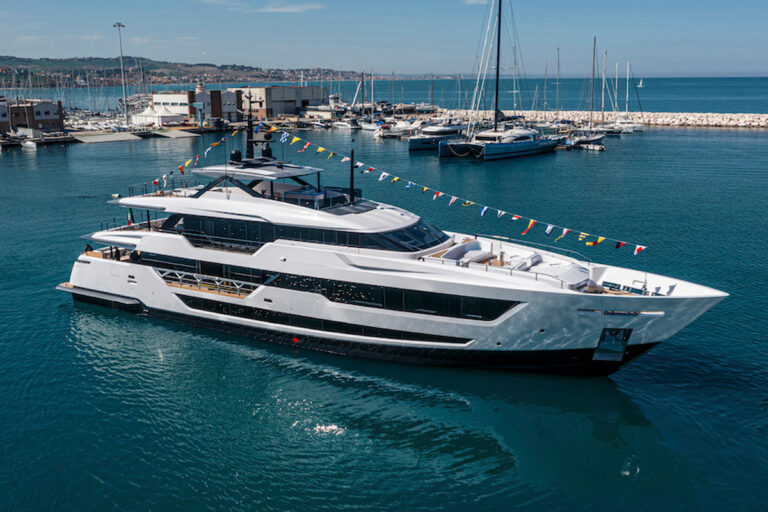Gas or diesel. Inboard or sterndrive. One stateroom or two. Even the television aboard the Cruisers 3470 Express rotates in a clever, barrel-shaped cabinet to face viewers forward or aft.
Never have I seen so much flexibility built into 35 feet.
Better yet, the flexibility in features and arrangement is matched by solid construction. This is one of the tightest, quietest, smoothest little yachts I’ve run in some time. As we sped up Pine Island Sound past Florida’s Sanibel Island in a moderate mix of wakes and waves, there was not a single rattle or squeak. Machinery vibration was nearly imperceptible. With our test boat’s standard Mercury 7.4L MPI gasoline engines, driving in a V-drive configuration, noise in the cabin at top speed (around 32 knots) was an acceptable 85 decibels. At a 25-knot cruise, noise dropped to a comfortable 76 decibels. Engine exhaust left the boat at the transom corners, carrying both noise and fumes with it.
The products being shipped from Cruisers’ plant in Oconto, Wisconsin, have improved considerably in recent years. Since becoming part of the KCS Group, along with Rampage and Shamrock, the yacht builder has gained the design freedom and financial backing needed to engineer and build top-notch boats for the family market. With a base price of $176,000, this boat is friendly to the family budget, as well. Even with a generous list of options, our test boat barely broke the $200,000 mark.
Performance during my tenure at the helm was, in a word, great. Acceleration from idle was quick with a minimum of bow rise, and throttle response through the middle and upper speed ranges was good. Once on plane, the running trim angle was quite low, yet there was little spray from the bow. The boat banked easily in turns and recovered quickly once the wheel was centered. We didn’t get a chance to run in any big slop, but I deliberately crisscrossed the wakes of the other Cruisers yachts running up to Captiva Island with us, and there was no evidence of pounding or dynamic instability.
The double helm seat to starboard is adjustable, letting you establish a firm brace against the solid, well-placed footrest built into the console. The windshield provides excellent protection whether sitting or standing, but if you want some air at the helm, it’s simple to open the hinged center section and vent panels to either side. That center section-along with steps molded into the console and a stout, fastened, stainless-steel handrail-allows quick, unencumbered access to the foredeck. With the standard bimini top and curtains in place, it’s easier to go forward via the side decks. Passage outboard was safe and easy (except where horns intruded on the starboard side) because of high side rails, nonslip on the deck and secure hand grabs on the radar arch.
Except for the sunpad on the foredeck, the topside layout is entirely abaft amidships. But that doesn’t mean guest space is limited. To port of the helm is a curved settee for two or three, and down one step aft is a large U-shape dinette. Opposite the dinette is a wet bar with space for a refrigerator or ice maker. A transom door leads to the spacious integral swim platform and aft stowage lockers. A section of the cockpit sole lifts easily with gas-assist struts to reveal the machinery space. Access to the engines is good, even with the optional 5 kW generator ($9,170). Naturally, larger engines will tighten the space up a bit, and sterndrive options mean a rearrangement of components.
Down several steps from the helm and through a sliding hatch, the cabin is light and airy, finished in flush cherry panels (a $6,530 option) and beige upholstery. There are two Bomar half-hatches, one over the head and one above the dinette, and a full hatch forward that not only provides light and ventilation, but serves as an emergency escape port from the accommodations. A large dinette is to starboard, facing the fully equipped galley. Also to port is the head, with an easy-to-clean, one-piece molded interior and separate shower.
A canted double berth and small hanging locker are in the master stateroom forward. A television cabinet in the bulkhead rotates and locks in place to face either the berth or the dinette without violating the stateroom’s privacy.
Abaft the dinette, our test boat had the second stateroom option ($1,350) with a double berth in place of the standard lounge area. Located under the helm station, headroom was limited but more than adequate for sleeping or sitting comfortably. It was a cinch to get in and out of the space. In the standard layout, a U-shape settee and small table convert to a berth, so forgoing the optional layout doesn’t preclude accommodating extra guests. A second hanging locker is included with either arrangement.
Contact: Cruisers Yachts, (920) 834-2211; fax (920) 834-2797; www.cruisersyachts.com.
POWER OPTIONS
The power package in our test boat, twin 310 hp Mercury 7.4L MPI gas engines coupled to V-drive gears, is one of the least expensive of the 21 engine and gear combinations offered on the Cruisers 3470 Express. It is not, however, substandard in any sense. While short of the 40-plus knots expected with the largest engines, these 454-cubic-inch V-8 engines still push the boat at more than 30 knots and cruise her in the mid-20s without breaking a sweat.
Drive options include V-drive reverse/reduction gears, and Merc Bravo III and Volvo DuoProp sterndrives. Power options include a broad array of engines from 230 hp Yanmar 230 diesels to 385 hp Crusader gas to Mercury and Volvo engines, both gas and diesel. The most expensive packages are Yanmar diesel V-drives and Volvo diesel sterndrives, at $34,000 to $37,000 more than our test boat. Least expensive is the 260 hp Merc 5.7L sterndrive setup, at $2,600 less.
Even if you need the shallow-water capability the sterndrives offer, opt for the bigger 7.4L blocks at a minimum and order the freshwater cooling unless yours is to be strictly a lake boat. You’ll want the power to keep speed up when the boat is fully loaded with fuel, water, guests and stores. Diesel options should be considered carefully against your expected use. Unless you are going to do a lot of cruising, the power decrease and extra up-front cost may not be justified.









